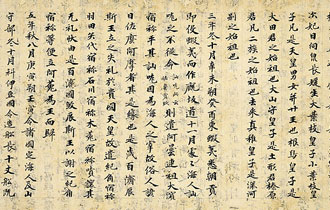Pages
|
Eating Meat for Health
Eating meat was avoided through much of Japan's history but, in reality, people never stopped eating it even in the most puritanical days. The prohibition first came as an imperial edict issued in A.D. 675 which specifically prohibited eating of ox, horse, dog, monkey, and fowl. A conspicuous lack of mention of deer and wild boar should be noted here. Although eating of meat was not sanctioned, people of all social classes continued to consume meat for various "medicinal" purposes. During the Tokugawa period, a store in Edo called Momonjiya specialized in selling meat of wild boar, deer, fox, tanuki, wolf, bear, river otter, skunk, cat, and wild dog, flourished as early as the beginning of the 18th century. Around the same time, records show that meat was available for purchase in Kōjimachi area of Edo. Archaeological excavations of mansions of samurai, such as one occupied by the Yonezawa Fief in present day Minato Ward in Tokyo, revealed a large amount of animal bones, suggesting large scale eating of meat by those who occupied the mansion in the beginning of the 17th century. Hikone Fief also customarily sent beef to the shogun as a gift and would happily oblige when shogun made a request for beef. They would send one shipment through the Nakasendō highway and another via Tōkaidō, so that if one failed to reach its destination for some reason, the other would surely succeed.
Cooking Basics
The milder seasoning of Japanese cooking is achieved by the use of cooking broth called dashi. In contrast to rich sauces made from animal fats, butter, cream, and flour, food cooked in dashi take on subtle flavor in addition to the ingredient's own. This broth is made from dried giant kelp (konbu) preferably harvested in the cold waters off of Hokkaidō and flakes of dried bonito, which are briefly boiled in water and then strained. Dashi came to be used in the Edo period; it is as ubiquitous as table salt in any Japanese cooking today if the food contains liquid.
Seasonings commonly used are shōyu (soy sauce), sake (as well as its sweet cooking variety called mirin), miso (fermented soybeans), rice vinegar, and salt. Oils used in Japanese cooking are those extracted from rapeseeds, soybeans, sesame seeds, and more recently corn.
A Japanese meal is typically served in the following way. First, clear soup (called osuimono or suimashijiru) or miso soup is served in a wooden lacquered bowl on the right side of the guest. A bowl of cooked rice in a ceramic bowl is placed to the left of the guest. Not observing this orientation of the bowls and switch their places is not recommended, as it denotes the way food is offered to the dead. Side dishes (okazu), served in variety of ceramic serving dishes, are placed on the far side. These could be fish, meat, and vegetables that are usually seasoned, prepared in a variety of ways (sliced, simmered, steamed, grilled, merely cut and mixed, to name a few of the standard procedures). All dishes are served at once, except when the food is kaiseki and chakaiseki and in some restaurants. Food is eaten with wooden or, less frequently, plastic chopsticks. In family style, side dishes may be shared by members of the family but each member eat from his/her own rice and soup bowls using own chopsticks. Table napkins are not usually available for Japanese meals as their need is not immediately perceived, although the guest might reserve the small wet towelette offered at the beginning of a meal to wipe off the hands (called oshibori) and use it like a napkin.
As explained in the section above about kaiseki ryōri, if people drink alcoholic drinks as the beginning part of a meal, they nibble on side dishes while doing so. Such a meal is usually followed by a soup, a bowl of rice, and pickles, and completed with a cup of tea and sweets or fruit.
Hiroshi Nara
Pages
|











